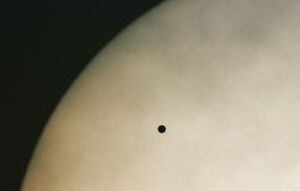Rare chance to see transit of Mercury
The colder and darker evenings are welcomed by the amateur astronomers of Shropshire.

We can have the pleasure of a couple of hours observing the night sky, and still enjoy our favourite tipple before an early night.
In addition this month, a transit of Mercury across the Sun takes place, which can be observed throughout Shropshire. On Monday, November 11, starting just after 12.30pm Mercury will start its transit across the Sun's disk for the first time since 2016.
Only planets that orbit the Sun inside of Earth’s orbit (Mercury and Venus) ever transit the sun, as seen from Earth. The passage of a planet across the face of the Sun is a relatively rare occurrence, with approximately 13 transits of Mercury each century, with the next being November 13, 2032. Mercury will appear as a tiny black dot moving across the disk of the Sun throughout the afternoon.
However because Mercury is so small and far away from Earth, you will need a telescope or binoculars with a proper Sun filter to see it. It is vital that you NEVER look directly at the Sun without proper eye protection, otherwise you can seriously hurt your eyes and even go blind.
You are most welcome to join members of the Shropshire Astronomical Society who will be gathering in the car park at Lyth Hill just outside Shrewsbury to experience the event from midday onwards.
For those who just like to gaze up at the night sky, the Leonids meteor shower peaks on the night of the 17th/18th. The Moon is coming up to third quarter so might restrict our view. However they do contain some larger particles, so some brighter meteors may well be seen.
Although the shower's radiant lies within the sickle of the constellation Leo, meteors may be spotted between the 15th and 20th of the month throughout the sky. The Leonids enter the atmosphere at about 71 km/sec and it might be possible to spot up to 15 meteors an hour if conditions are favourable.
Although Saturn is heading towards the horizon there is still an opportunity to get a view as dusk falls. Search just south west close to the horizon and you should be lucky. Remember that stars twinkle but planets do not. With a pair of binoculars you should be able to see Titan, Saturn's largest moon, but you will need a magnification of at least x25 (a small 3ins or 4ins telescope will be plenty) to see the mystical rings.
Up to 11th of the month the International Space Station will be visible in the hours before dawn. Generally, the space station is only visible in the hour or so before dawn or the hour or so after sunset. This is because it is dark and yet the Sun is not too far below the horizon so that it can light up the space station. It will usually be seen to the south, and is only visible for a minute or so at each sighting but is not difficult to spot.
The Shropshire Astronomical Society, which meets monthly on the second Saturday at Little Ness Village Hall and on the third Saturday at Rodington Village Hall, hosts a wide range of observing events, and always welcomes experienced or novice stargazers. For further information visit www.shrophire-astro.uk
By Steve Szwajkun, Shropshire Astronomical Society





